CHEM303 final exam review PDF

| Title | CHEM303 final exam review |
|---|---|
| Author | Mia Levine |
| Course | Physical Chemistry for the Biochemical Sciences |
| Institution | University of Maryland Baltimore County |
| Pages | 4 |
| File Size | 40.1 KB |
| File Type | |
| Total Downloads | 113 |
| Total Views | 193 |
Summary
Dr Geddes. thermodynamics, chemical potential, ionic solutions, equilibrium...
Description
Lecture 1: Thermodynamics Overview Random error Pressure-volume work w = - [integral] PdV W = - P[delta]V if pressure is constant Mechanical work Work done on a system is positive The 0th Law of Thermodynamics Two systems in thermal equilibrium with a third are in equilibrium with each other Heat q = pt t = time The change in temperature it produces upon flowing into a definite amount of sustance Power p = EI E = potential difference I = electric current Homogenous system Heterogenous system Intensive variable INDEPENDENT of size Extensive variable
Lecture 2: Chemical Equations, The First Law of Thermodynamics (Conservation of Energy) A state function is path-independent Isochoric Adiabatic Internal Energy [delta]U = q + w The 1st Law of Thermodynamics Conservation of energy [delta]U = q for a process at constant volume [delta]H = q at constant pressure Enthalply H = U + PV Heat Capacity C = U/T = q/T at constant volume C = H/T = q/T constant pressure
Lecture 3: The Second Law of Thermodynamics (Entropy) Hess’s Law standard enthalpies of individuals reactions can be combined The Second Law of Thermodynamics total entropy of any system cannot decrease other than by increasing the entropy of another system dS = q / T Order and Disorder Disorder = Disorder Capacity / Information Capacity Order = 1 - Order Capacity / Information Capacity
Lecture 4: Kirchoff’s Law, The Third Law of Thermodynamics Relationship between heat capacities C(p) - C(v) = nR Kirchoff’s Law change of standard reaction enthalpy, based on enthalpy, heat capacity and temperature The Third Law of Thermodynamics the entropy of any pure substance in a perfect crystalline state is 0 at T=0
Lecture 5: Thermodynamic Function, Criteria for Spontaneous Changes and Chemical Equilibrium Combined First and Second Laws dU = TdS - PdV dH = TdS +VdP Helmholtz free energy A = U - TS Useful work, constant T and V Gibbs free energy G = H - TS dA = -PdV - SdT dG = VdP - SdT If Gibbs free energy is less than 0, spontaneous Useful work, constant T and V Entropy of Mixing when two substances mix, available volume changes, increasing uncertainty and entropy Gibbs paradox slightest difference between substances yields big entropy change
Lecture 6: Chemical Potential Chemical potential think about electrical potential but the chemical version! Partial molar quantity V = [delta]V / [delta]n Extent of reaction [delta]squiggle = [derivative]n/v
vi = stoichiometric numbers (positive for products, negative for reactants) n = amount of reactant Ri = reactant Activity a = exp[(mu - md,std) - (RT)] mu = mu,std + RTln(a) mu,std = standard chemical potential [delta]G = [sigma]v(mu,std) Reaction Quotient the relative proportion of products and reactants present in the reaction mixture at some instant time (use current concentrations rather than equilibrium concentrations) Q = [pi](a)^v = (P,c^c)(P,d^d) / (P,a^a)(P,b^b) Le Chatelier’s Principle if system at equilibrium experiences a change, the equilibrium will shift to counteract that change Q < K reaction moves right (actual smaller than equilibrium, must move to products) Activity Coefficient a factor used to account for deviations from ideal K = [pi](a)^v = [pi](c)^v * [pi](gamma)^v [gamma] = a(P,std) / (P,i) P,i = partial pressure [gamma] = a(c,std) / (c,i) [gamma] = a(m,std) / (m,i) [gamma] = a/x,i Activity coefficients have different values on different scales Gases approach ideal as pressure gets very low Fugacity the tendency of a substance to prefer one phase over another A substance has a different fugacity for each phase The lowest will be the most favorable The unit is the same as pressure K as a Function of T ***LnK = -H/RT + S/R*** Differentiate to get the van’t Hoff equation
Lecture 7: Ionic Solutions, Electrochemistry, pH Debye-Huckel constant Am ln[gamma] = -A(m,i)(z^2)(I^0.5) for low ionic strengths (< 0.01 mol/kg) ln[gamma] = -A(m,i)(z^2)(I^0.5) / (1 + BI^0.5) I = ½[sigma]mz^2 = ionic strength z = charge on ion m,i = molality = n/(M,s*n,s) n= mol M,s = molar mass n,s = amount of solvent
Mean ionic activity coefficients a way to “average” activity via multiplication and powers rather than addition and multiplication Nernst Equation equilibrium reduction potential E = E,std - (RT/[vF])lnQ v = number of electrons Q = reaction quotient Standard Half Cell Potentials E,std = E,std,cathode - E,std,anode The Henderson-Hasselbach Equation
Lecture 8: Equilibrium Identical and Independent Binding Cooperative Binding the first ligand to bind makes it easier for the next Anti-cooperative binding Excluded-side binding binding at one site completely excludes binding at another side...
Similar Free PDFs
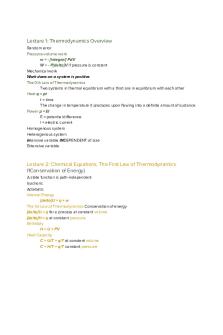
CHEM303 final exam review
- 4 Pages

Chem Final Exam Review
- 12 Pages

Final Exam - Review notes
- 92 Pages

Bio Final Exam Review
- 2 Pages

Final EXAM Review booklet
- 5 Pages

Psychology Final Exam - Review
- 13 Pages
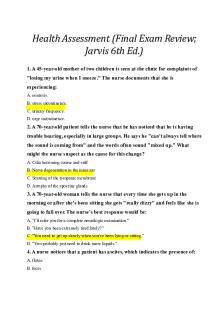
Jarvis Final Exam Review
- 12 Pages
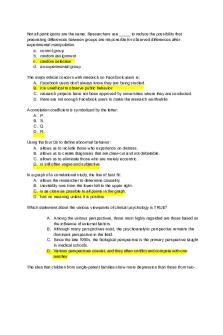
Final exam review
- 96 Pages
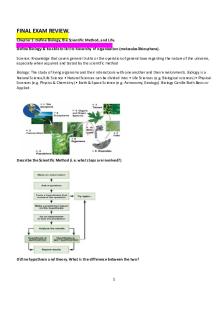
Final Exam Review
- 48 Pages
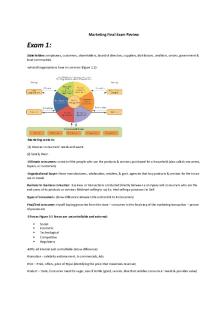
Marketing Final Exam Review
- 15 Pages
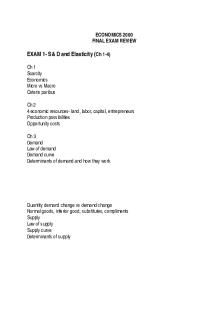
Final exam review
- 8 Pages
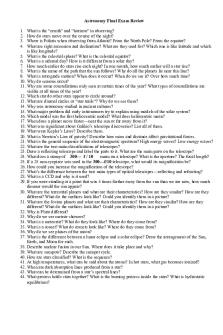
Astronomy Final Exam Review
- 2 Pages
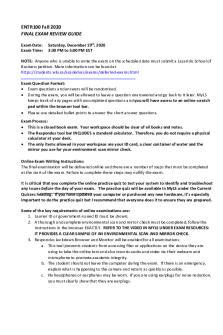
Final Exam Review Guide
- 4 Pages

Final exam review flsp4420
- 5 Pages

Theo Final Exam Review
- 16 Pages

Entrepreneurship final exam review
- 33 Pages
Popular Institutions
- Tinajero National High School - Annex
- Politeknik Caltex Riau
- Yokohama City University
- SGT University
- University of Al-Qadisiyah
- Divine Word College of Vigan
- Techniek College Rotterdam
- Universidade de Santiago
- Universiti Teknologi MARA Cawangan Johor Kampus Pasir Gudang
- Poltekkes Kemenkes Yogyakarta
- Baguio City National High School
- Colegio san marcos
- preparatoria uno
- Centro de Bachillerato Tecnológico Industrial y de Servicios No. 107
- Dalian Maritime University
- Quang Trung Secondary School
- Colegio Tecnológico en Informática
- Corporación Regional de Educación Superior
- Grupo CEDVA
- Dar Al Uloom University
- Centro de Estudios Preuniversitarios de la Universidad Nacional de Ingeniería
- 上智大学
- Aakash International School, Nuna Majara
- San Felipe Neri Catholic School
- Kang Chiao International School - New Taipei City
- Misamis Occidental National High School
- Institución Educativa Escuela Normal Juan Ladrilleros
- Kolehiyo ng Pantukan
- Batanes State College
- Instituto Continental
- Sekolah Menengah Kejuruan Kesehatan Kaltara (Tarakan)
- Colegio de La Inmaculada Concepcion - Cebu